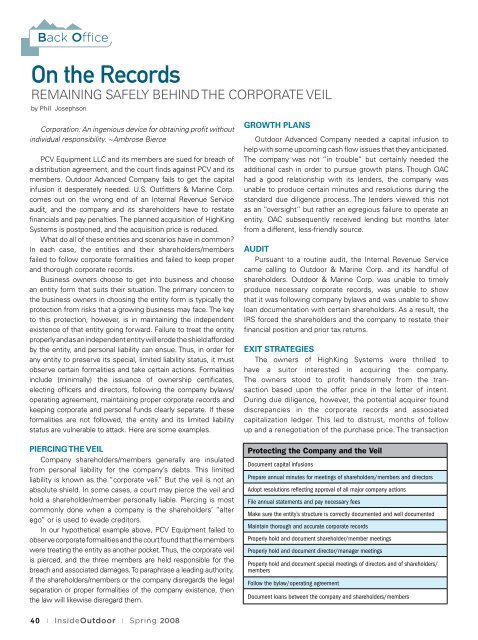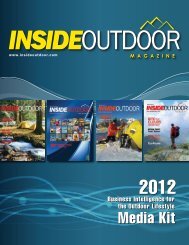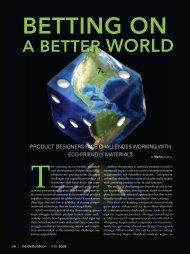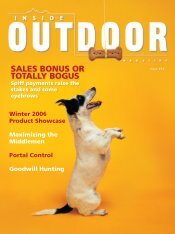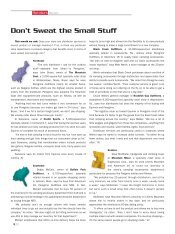Spring - InsideOutdoor Magazine
Spring - InsideOutdoor Magazine
Spring - InsideOutdoor Magazine
Create successful ePaper yourself
Turn your PDF publications into a flip-book with our unique Google optimized e-Paper software.
Back Office<br />
On the Records<br />
Remaining safely behind the corporate veil<br />
by Phil Josephson<br />
Corporation: An ingenious device for obtaining profit without<br />
individual responsibility. ~Ambrose Bierce<br />
PCV Equipment LLC and its members are sued for breach of<br />
a distribution agreement, and the court finds against PCV and its<br />
members. Outdoor Advanced Company fails to get the capital<br />
infusion it desperately needed. U.S. Outfitters & Marine Corp.<br />
comes out on the wrong end of an Internal Revenue Service<br />
audit, and the company and its shareholders have to restate<br />
financials and pay penalties. The planned acquisition of HighKing<br />
Systems is postponed, and the acquisition price is reduced.<br />
What do all of these entities and scenarios have in common?<br />
In each case, the entities and their shareholders/members<br />
failed to follow corporate formalities and failed to keep proper<br />
and thorough corporate records.<br />
Business owners choose to get into business and choose<br />
an entity form that suits their situation. The primary concern to<br />
the business owners in choosing the entity form is typically the<br />
protection from risks that a growing business may face. The key<br />
to this protection, however, is in maintaining the independent<br />
existence of that entity going forward. Failure to treat the entity<br />
properly and as an independent entity will erode the shield afforded<br />
by the entity, and personal liability can ensue. Thus, in order for<br />
any entity to preserve its special, limited liability status, it must<br />
observe certain formalities and take certain actions. Formalities<br />
include (minimally) the issuance of ownership certificates,<br />
electing officers and directors, following the company bylaws/<br />
operating agreement, maintaining proper corporate records and<br />
keeping corporate and personal funds clearly separate. If these<br />
formalities are not followed, the entity and its limited liability<br />
status are vulnerable to attack. Here are some examples.<br />
Piercing the Veil<br />
Company shareholders/members generally are insulated<br />
from personal liability for the company’s debts. This limited<br />
liability is known as the “corporate veil.” But the veil is not an<br />
absolute shield. In some cases, a court may pierce the veil and<br />
hold a shareholder/member personally liable. Piercing is most<br />
commonly done when a company is the shareholders’ “alter<br />
ego” or is used to evade creditors.<br />
In our hypothetical example above, PCV Equipment failed to<br />
observe corporate formalities and the court found that the members<br />
were treating the entity as another pocket. Thus, the corporate veil<br />
is pierced, and the three members are held responsible for the<br />
breach and associated damages. To paraphrase a leading authority,<br />
if the shareholders/members or the company disregards the legal<br />
separation or proper formalities of the company existence, then<br />
the law will likewise disregard them.<br />
Growth Plans<br />
Outdoor Advanced Company needed a capital infusion to<br />
help with some upcoming cash flow issues that they anticipated.<br />
The company was not “in trouble” but certainly needed the<br />
additional cash in order to pursue growth plans. Though OAC<br />
had a good relationship with its lenders, the company was<br />
unable to produce certain minutes and resolutions during the<br />
standard due diligence process. The lenders viewed this not<br />
as an “oversight” but rather an egregious failure to operate an<br />
entity. OAC subsequently received lending but months later<br />
from a different, less-friendly source.<br />
Audit<br />
Pursuant to a routine audit, the Internal Revenue Service<br />
came calling to Outdoor & Marine Corp. and its handful of<br />
shareholders. Outdoor & Marine Corp. was unable to timely<br />
produce necessary corporate records, was unable to show<br />
that it was following company bylaws and was unable to show<br />
loan documentation with certain shareholders. As a result, the<br />
IRS forced the shareholders and the company to restate their<br />
financial position and prior tax returns.<br />
Exit Strategies<br />
The owners of HighKing Systems were thrilled to<br />
have a suitor interested in acquiring the company.<br />
The owners stood to profit handsomely from the transaction<br />
based upon the offer price in the letter of intent.<br />
During due diligence, however, the potential acquirer found<br />
discrepancies in the corporate records and associated<br />
capitalization ledger. This led to distrust, months of follow<br />
up and a renegotiation of the purchase price. The transaction<br />
Protecting the Company and the Veil<br />
Document capital infusions<br />
Prepare annual minutes for meetings of shareholders/members and directors<br />
Adopt resolutions reflecting approval of all major company actions<br />
File annual statements and pay necessary fees<br />
Make sure the entity’s structure is correctly documented and well documented<br />
Maintain thorough and accurate corporate records<br />
Properly hold and document shareholder/member meetings<br />
Properly hold and document director/manager meetings<br />
Properly hold and document special meetings of directors and of shareholders/<br />
members<br />
Follow the bylaw/operating agreement<br />
Document loans between the company and shareholders/members<br />
40 | <strong>InsideOutdoor</strong> | <strong>Spring</strong> 2008


